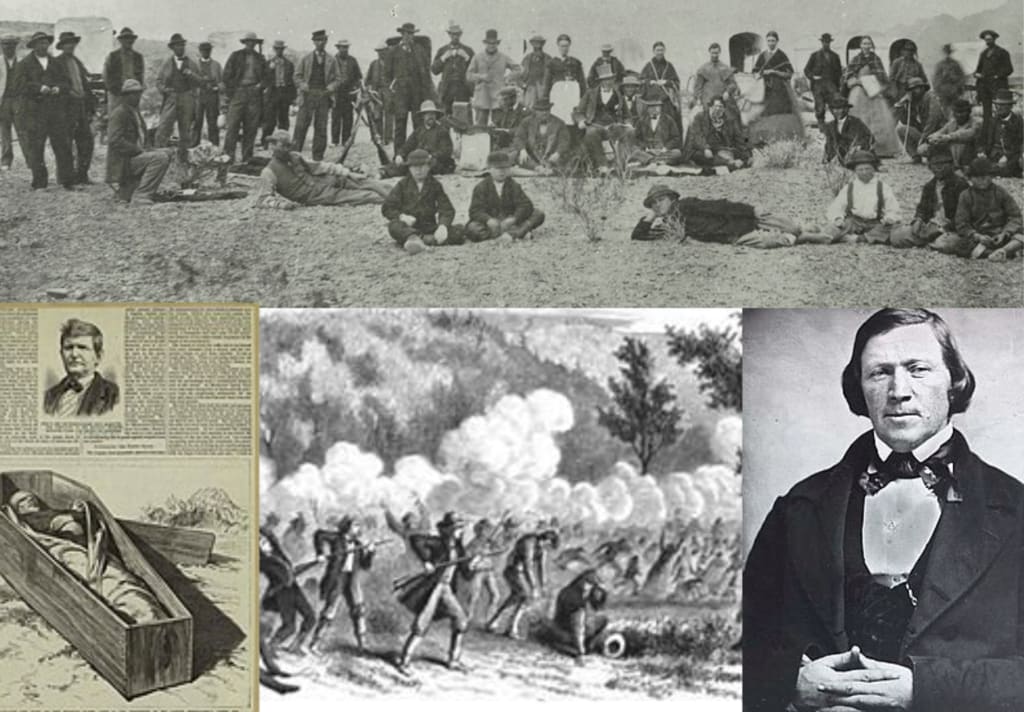The Mormon Massacre at Mountain Meadows
For years, Paiute Indians were blamed

At the beginning of their religion, the Mormon Church had many enemies. They had been the victims of violence and were constantly moving, looking for a home.
That all changed in September 1857, when the Mormons instigated several attacks known as the Mountain Meadows Massacre. It is considered the darkest incident in Mormon history and one of the most explosive episodes in America.
Salt Lake
The Mormons first arrived in Salt Lake in 1847. At the time, Salt Lake was part of Mexican territory. However, shortly after they arrived, the territory was taken by the U.S. in the Mexican-American War.
As a compromise in 1850, President Fillmore appointed a prominent member of the Mormon Church as governor. It wasn't long after Brigham Young's appointment that conflict started.
From the start of his presidency, James Buchanan was clear that he would not be weak. When the conflicts started, he sent 20% of the American army to the area to assert federal supremacy in Utah.
When Mormons heard this, they were reminded of past extermination orders and sanctioned violence against them. Young prepared for war.
The strategy that Young decided on was rather than fight the army directly. They would attack the supply trains.
In addition, they closed the trails that the emigrants were using to pass through Utah to California. They managed this by forbidding Mormons from selling supplies to any emigrants.
They also supported local Native American tribes in taking the cattle that accompanied the wagon trains. With this strategy, Young pushed local Mormons towards hostility and violence.
The Massacre
The Fancher Party were an emigrant group travelling from Arkansas. They were attacked along the route, two hundred miles south of Salt Lake. The party camped at the beautiful Alpine valley of Mountain Meadows.
A famous Mormon missionary, Parley Pratt, had recently been murdered, and rumour had reached the Mormons that the Fancher Party were insulting his memory through their behaviour.
A local Mormon militia joined up with a group of Paiute Indians. Together, they attacked the party at dawn on 7th September 1857.
John Lee led the group. Lee was extremely shocked when the group proved to be a formidable foe. The battle went on for several days. Eventually, though, they began to run out of ammunition and provisions.
During this time, the Fancher party also observed that some of the attackers were Mormons. Before this, the Mormons had hoped to pass this off as an Indian attack.
The Mormons approached the party waving a white flag. They offered the settlers a truce, safe passage out if they left their livestock for the Paiutes. The group laid down their weapons.
When the group agreed, fearing reprisals, the Mormons knew they had only one choice: to kill all those old enough to testify against them. Every man, woman, and child over seven was slaughtered a total of 120 people.
The group then took a vow of silence and blamed the whole attack on the Paiutes. The local population took in the seventeen children that they had not massacred.
End of War
The Mormon War ended quickly as the soldiers arrived in Salt Lake City in June 1858. Young would step down and make way for a new governor of Utah, and President Buchanan pardoned all Mormons involved in the rebellion.
The following year, troops led by Major James H. Carleton went to Mountain Meadows to investigate the killings and found the bones of tiny children.
Lee became a fugitive until his capture in November 1874. He went on trial for murder the following year. This trial ended with a hung jury.
Lee continued with the story that the attack was the Paiutes. This was the official position of the Church for generations.
Young struck a deal with the U.S. Attorney in exchange for evidence he could provide of Lee's guilt; the prosecutor would not pursue a conviction against any other Mormon.
The time has come when they will try John D. Lee and not the Mormon Church, and that is all we have ever wanted. - Young
Lee was convicted in 1876 and executed at Mountain Meadows in 1877. He continued to claim he was a scapegoat and that Mormons in higher positions had been directly involved in the planning and killing.
On 20th April 1961, the joint council was held, and after considering all the facts, the Church reinstated John Lee's membership.
This puzzled many until, on 11th September 2007, the LDS Apostle Jenry B. Earring read the following statement:
We express profound regret for the massacre carried out in this valley 150 years ago today, and for the undue and untold suffering experienced by the victims then and by their relatives to the present time. A separate expression of regret is owed the Paiute people who have unjustly borne for too long the principal blame for what occurred during the massacre. Although the extent of their involvement is disputed, it is believed they would not have participated without the direction and stimulus provided by local church leaders and members.
About the Creator
Sam H Arnold
Writing stories to help, inspire and shock. For all my current writing projects click here - https://linktr.ee/samharnold






Comments
There are no comments for this story
Be the first to respond and start the conversation.